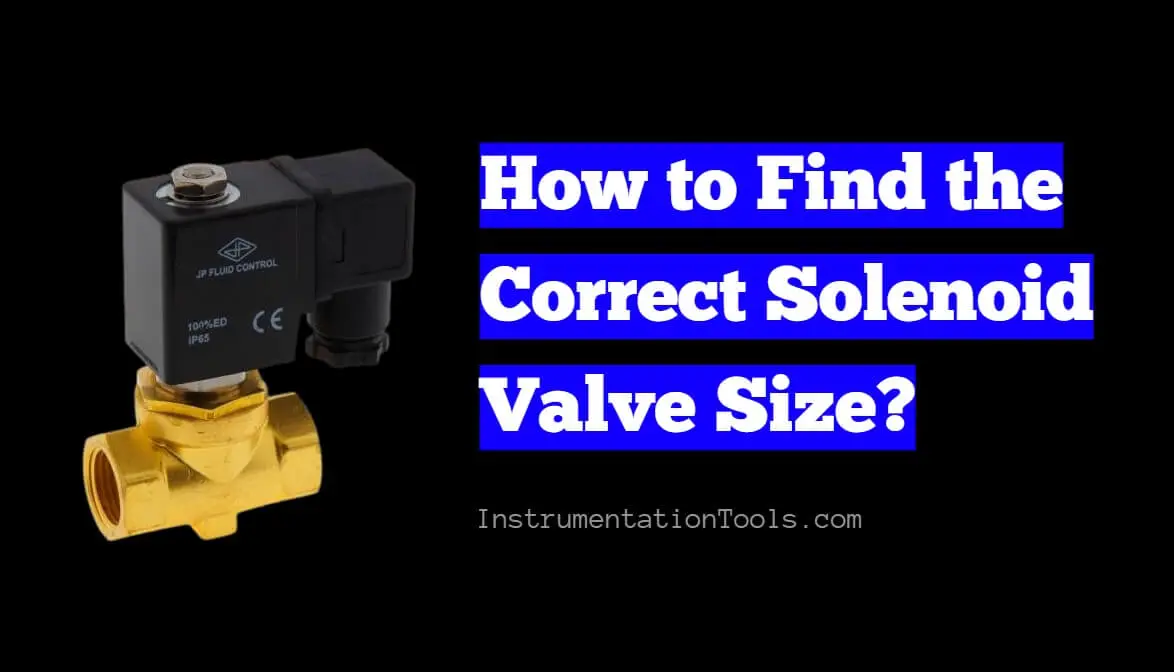When we speak about solenoid valve sizing, we refer to the amount of flow passing through the valve, also known as the flow factor (Kv).
This Kv-value is a measure of the flow rate for a given medium and pressure drop.
Before choosing a solenoid valve, we need to know the flow rate to start to determine our choice for the correct valve for our application.
However, just knowing the Kv-value will not allow us to make the right choice all by itself. The circuit function, operating principle, IP rating, medium, pressure, and other selection factors play a significant role.

Our first step will be to determine what this value is, followed by how to calculate it. It is important to note that countries that use imperial units have a slightly different value, the Cv value.
The Cv value is calculated as the volume flow rate of water in gallons per minute at 60 degrees Fahrenheit at a pressure drop of 1 psi. Based on these values, Kv is 1.156 times Cv.
When choosing a solenoid valve, we use the Kv value rather than the pipe size or diameter of the pass-through. The Kv value can vary per valve, and the medium that flows through the valve is still the deciding factor.
Solenoid valves have a standard Kv-value assigned to them. This value represents the amount of water, which has a specific gravity of 1, which can pass through the valve at a pressure differential of 1 bar.
The flow rate of a solenoid valve depends on the shape of the valve’s body (route the media flow takes) and the diameter of the orifice.
The orifice is the diameter of the hole that will be closed off in the valve. If the piping connections of the valve are large, often the orifice will be large as well.
A larger orifice will have greater flow. Besides the flow rate, there are other factors we should know before we can calculate our valve size.
The first is specific gravity. This is more commonly known as the relative density of materials. We can define specific gravity (G) as the ratio between the weight of a substance and an equal volume of water at 4 °C. At this temperature, it has a density of 1.0 kg per liter. Therefore water has a specific gravity of 1.
We also need to know the inlet and outlet pressures to calculate the pressure drop. Suppose a water pipe in a house has a pressure of 1 bar. This pipe flows to the outside air or atmosphere, which has a pressure of zero bar. This pressure difference of 1 bar is what we call the pressure drop.
The valve we’ve connected to the pipe has a Kv-value of 3. At a pressure drop of 1 bar, the flow rate for this valve is three cubic meters per hour (Kv-value x pressure drop).
We can combine all these factors in the following mathematical equation:
Where:
Q = Flow rate [m3/hour]
dp = The differential pressure between the inlet and outlet [bar]
SG = Specific Gravity
Kv = Flow coefficient
We will connect a solenoid valve in a farm which is connected to a milk transporting pipe. We need to calculate now the size of the solenoid valve we will choose.
We know the following:
We found a solenoid valve that might suit our needs. This valve comes with a Kv value of 1.25. Will this valve be able to give us the flow we need?
Using the calculation, we see the following:
We know now that this valve will give us 0.8992 cubic meters per hour.
If we calculate the liters per minute:
This valve will give us 14.98 liters of milk per minute, which is perfect for our application.
Now we know that our valve has a flow rate suitable for us; we also need to know several other factors to determine if the solenoid valve is suitable for us.
Solenoid valves come in three different operating modes:
Indirect operated valves need a minimum pressure differential of 0.5 bar for proper operation. This gives the advantage that indirectly operated valves can control large flows with a relatively small coil, thereby reducing energy consumption.
Our system works with a pressure differential of 2 bar and has a relatively large flow.
There are various circuit functions available, 2/2-way, 3/2-way, and more. A 2/2-way valve has two ports (inlet and outlet) and two open and closed positions.
For our application, we need a relatively simple operation with an inlet and outlet, so the 2/2 way valve is perfect.
We also need the valve to open only at the right moment, which means a valve that is closed as standard, or normally closed (NC).
The below are the basic parameters
2 bar for our system.
The response time depends on the construction of the valve, the coil properties, the atmospheric pressure, and the medium’s viscosity.
The response time of DC valves is slower than AC valves. Direct operating valves are faster than indirect valves in most cases.
Indicates the degree of protection against access to hazardous parts and ingress of water, dust, etc. We need a valve that can withstand washing down and steam cleaning, so a high IP rating such as IP69K.
Once we know all these factors, we can rest assured that the solenoid valve we choose is the correct one for our application.
Learn an example PLC program to control a pump based on level sensors using ladder…
In the PLC timer application for security camera recording, when motion is detected then camera…
In this example, we will learn batch mixing with PLC ladder logic program using timer…
This PLC example on manufacturing line assembly is an intermediate-level PLC program prepared for the…
In this article, you will learn the PLC programming example with pushbutton and motor control…
This article teaches how to convert Boolean logic to PLC programming ladder logic with the…